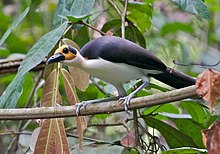White-necked rockfowl
| White-necked rockfowl | |
|---|---|
 |
|
| Scientific classification | |
| Kingdom: | Animalia |
| Phylum: | Chordata |
| Class: | Aves |
| Order: | Passeriformes |
| Family: | Picathartidae |
| Genus: | Picathartes |
| Species: | P. gymnocephalus |
| Binomial name | |
|
Picathartes gymnocephalus (Temminck, 1825) |
|
 |
|
| The distribution of the white-necked rockfowl (pink), along with the grey-necked rockfowl (green) | |
| Synonyms | |
|
|
The white-necked rockfowl (Picathartes gymnocephalus) is a medium-sized bird in the family Picathartidae, with a long neck and tail. Also known as the white-necked picathartes, this passerine is mainly found in rocky forested areas at higher altitudes in West Africa from Guinea to Ghana. Its distribution is patchy, with populations often being isolated from each other. The rockfowl typically chooses to live near streams and inselbergs. It has no recognized subspecies, though some believe that it forms a superspecies with the grey-necked rockfowl. The white-necked rockfowl has greyish-black upperparts and white underparts. Its unusually long, dark brown tail is used for balance, and its thighs are muscular. The head is nearly featherless, with the exposed skin being bright yellow except for two large, circular black patches located just behind the eyes. Though the bird is usually silent, some calls are known.
These rockfowl feed primarily on insects, though parents feed small frogs to their young. One feeding strategy involves following Dorylus army ant swarms, feeding on insects flushed by the ants. Rockfowl move through the forest primarily through a series of hops and bounds or short flights in low vegetation. This species rarely flies for long distances. The white-necked rockfowl is monogamous and pairs nest either alone or in the vicinity of other pairs, sometimes in colonies with as many as eight nests. These nests are constructed out of mud formed into a deep cup and are built on rock surfaces, typically in caves. Two eggs are laid twice a year. Though the birds breed in colonies, infanticide is fairly common in this species, with rockfowl attempting to kill the young of other pairs. Nestlings mature in about a month. This bird is long-lived.
This species is classified as Vulnerable as its dwindling and fragmented populations are threatened by habitat destruction. Conservation efforts are underway in parts of its range in the form of habitat protection, education efforts, and new laws. Some of the indigenous peoples of Sierra Leone considered the species to be a protector of the home of their ancestral spirits. This rockfowl is considered one of Africa's most desirable birds by birders and is a symbol of ecotourism across its range.
...
Wikipedia

